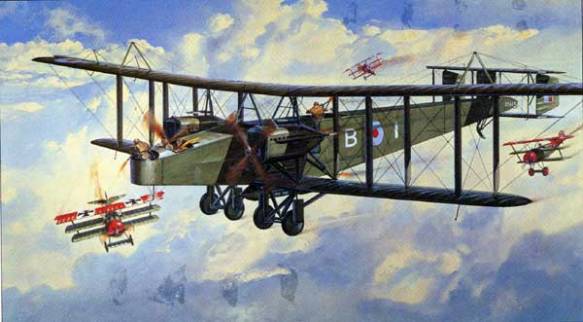The Handley Page O/100 biplane was the first true heavy bomber manufactured by the British. Specifically designed for the purpose of bombing Germany, an order for forty aircraft was placed while the design was still on the drawing board. On 1 January 1917, four new O/100 bombers took off for delivery to France. Unfortunately, one of the new bombers was captured by the Germans when its pilot inadvertently landed at an enemy aerodrome.
The Handley Page Type O was an early biplane bomber used by Britain during the First World War. At the time, it was the largest aircraft that had been built in the UK and one of the largest in the world. It was built in two major versions, the Handley Page O/100 (H.P.11) and Handley Page O/400 (H.P.12).
The O/400 was Britain’s first strategic bomber and, for many months, the largest aircraft assembled on the British Isles. It flew successful missions over Germany and also dropped the largest Allied bombs of the war.
Sir Frederick Handley Page established the first English factory solely dedicated to manufacturing airplanes in 1909. Six years later, the Admiralty issued specifications for a large two-engine patrol-bomber, which they deemed “a bloody paralyzer.” In the spring of 1916, Handley Page responded with his model O/100. This giant craft was a three-bay biplane and powered by two tractor engines mounted in nacelles between the wings. The long, boxy fuselage was of conventional construction but featured a large biplane tail section. The craft was also unique for its time in that bombs were carried in a rudimentary bomb bay. That summer the O/100 entered production, with 42 being built. The Royal Navy initially employed them for maritime reconnaissance, but losses forced them to switch to nighttime bombing.
In the spring of 1917 a more refined version, the O/400, was introduced. This differed mainly in possessing more powerful engines and a fuel system that was relocated from the nacelles to the fuselage. This version was issued to the RAF’s Independent Force and equipped its very first strategic bomber units. In response to the various Gotha raids over London, the Air Board ordered the O/400s to hit back at the German mainland. On the evening of August 25, 1918, two machines from No. 215 Squadron did exactly that by staging a successful low-altitude (200 feet) raid that severely damaged a chemical factory in Mannheim.
Commencing that September, O/400s were dispatched over German targets in groups of 40 or so, both at day and night, with good effect. Some of these aircraft unloaded a 1,650-pound bomb—England’s biggest—on industrial targets in the Rhineland. By the time of the Armistice, 440 O/400s had been manufactured and were being supplanted by an even bigger craft, the V/1500. Both were replaced in turn by Vickers Vimys during the 1920s.
Variants
O/100
Original bomber version for RNAS – Two 260 hp (190 kW) Rolls-Royce Eagle II engines. Four prototypes and 42 production aircraft built.
O/400
Improved bomber for RFC/RAF – Two 360 hp (270 kW) Rolls-Royce Eagle VIII engines. 554 built.
O/7
Export transport version for China to carry 14 passengers. Lengthened engine nacelles for fuel tanks moved from fuselage; 12 conversions.
O/10
Transport variant to carry 12 passengers; 10 conversions.
O/11
Variant of the O/7 for mixed passenger/cargo use, two passengers up front and three in the very rear, with a freight in between; three conversions.
Specifications (O/100)
Country: Great Britain
Manufacturer: Handley Page Ltd.
Type: Heavy Bomber
Entered Service: November 1916
Number Built: 40
Engine(s): 2 Rolls Royce Eagle II, 12 cylinder, liquid cooled, inline V, 250 hp
Wing Span: 100 ft [30.48 m]
Length: 62 ft 10¼ in [19.15 m]
Height: 22 ft [6.71 m]
Empty Weight:
Gross Weight: 14,020 lb [6,359.4 kg]
Max Speed: 85 mph [137 km/h] at sea level
Ceiling: 7,000 [2,134 m]
Endurance: 8 hours
Crew: 4
Armament: 4-5 machine guns
1,792 lb [812.8 kg] of bombs
Specifications (O/400)
General characteristics
Crew: 4 or 5
Length: 62 ft 10¼ in (19.16 m)
Wingspan: 100 ft (30.48 m)
Height: 22 ft (6.71 m)
Wing area: 1,648 ft² (153.1 m²)
Empty weight: 8,502 lb (3,856 kg)
Max takeoff weight: 13,360 lb (6,060 kg)
Powerplant: 2 x Rolls-Royce Eagle VIII inline piston, 360 hp (268 kW) each
Performance: Maximum speed: 97.5 mph (84.7 kn, 157 km/h)
Range: 608 nmi (700 mi, 1,120 km)
Service ceiling: 8,500 ft (2,600 m)
Rate of climb: 23 min to 5,000 ft
Endurance: 8 hours
Armament: Guns: 5 x 0.303 in (7.7 mm) Lewis Guns (2 on nose Scarff ring, 2 on dorsal position and 1 at ventral hatch)
Bombs: Up to 2,000 lb (907 kg) of bombs
Avionics: Drift Sight Mark IA, an early mechanical bombsight
